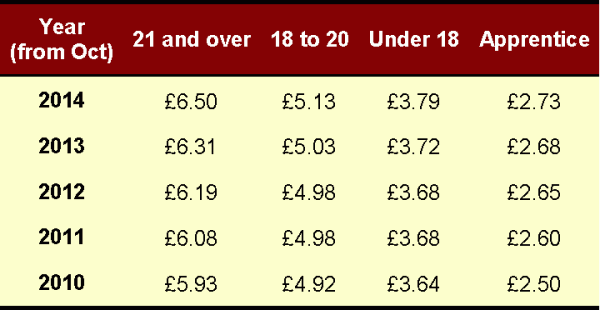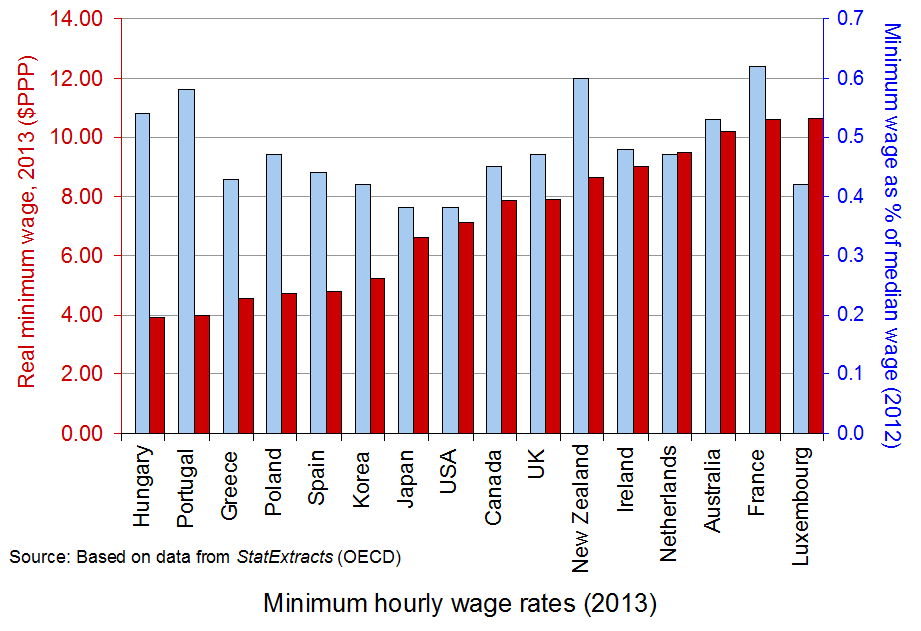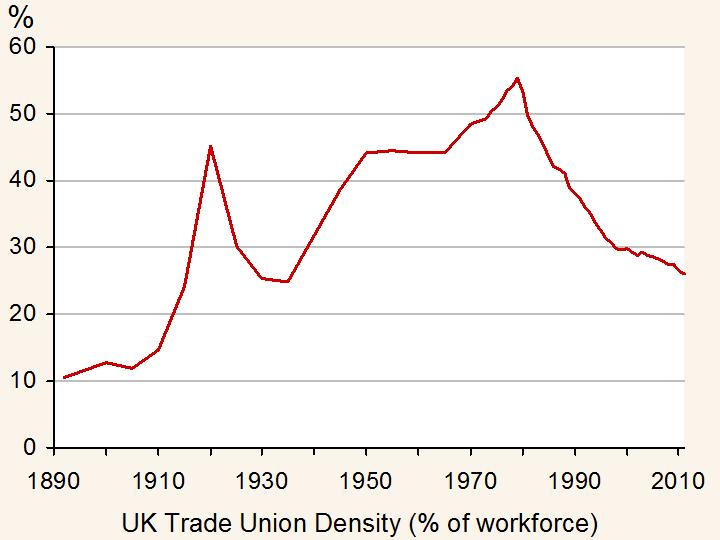 In the blog Effects of raising the minimum
In the blog Effects of raising the minimum
wage, the policy of an above-inflation rise in the minimum wage was discussed, as this had been advocated by political leaders. Over the past 5 years, the minimum wage has fallen in real terms, but from October 2014, the national minimum wage will increase 19p per hour and this rise will be the first time since 2008 when the increase will be higher than inflation.
The National Minimum Wage is a rate applied to most workers in the UK and is their minimum hourly entitlement. For adults over the age of 21, it will be increased by just over 3% to £6.50. Rises will also occur for 18-20 year olds, though their increase will be lower at 10p and will take the hourly wage to £5.13 an hour, representing a 2% rise.  Those aged 16 and 17 will also see a 2% rise, taking their wage up by 7p to £3.79. With inflation currently at 1.9% (as measured by the CPI), these rises outstrip inflation, representing a real increase in the minimum wage. Undoubtedly this is good news for workers receiving the minimum wage, and it is thought that millions of workers will benefit.
Those aged 16 and 17 will also see a 2% rise, taking their wage up by 7p to £3.79. With inflation currently at 1.9% (as measured by the CPI), these rises outstrip inflation, representing a real increase in the minimum wage. Undoubtedly this is good news for workers receiving the minimum wage, and it is thought that millions of workers will benefit.
Vince Cable said:
The recommendations I have accepted today mean that low-paid workers will enjoy the biggest cash increase in their take home pay since 2008…This will benefit over one million workers on national minimum wage and marks the start of a welcome new phase in minimum wage policy.
While this rise has been praised, there are still suggestions that this minimum wage is too low and does not represent a ‘living wage’. The General Secretary of Unison said:
Across the country people are struggling to make ends meet. The sooner we move to a Living Wage the better. The real winners today will again be payday loan sharks who prey on working people, unable to bridge the financial gap between what they earn and what their families need to survive.

(Click here for a PowerPoint of the above chart.)
The Chancellor eventually wants to increase the minimum wage to £7 per hour, but there will undoubtedly be an impact on businesses of such a rise. Is it also possible that with the national minimum wage being pushed up, unemployment may become a problem once more?
Market wages are determined by the interaction of the demand and supply of labour and when they are in equilibrium, the only unemployment in the economy will be equilibrium unemployment, namely frictional or structural. However, when the wage rate is forced above the equilibrium wage rate, disequilibrium unemployment may develop. At a wage above the equilibrium the supply of labour will exceed the demand for labour and the excess is unemployment.
By increasing the national minimum wage, firms will face higher labour costs and this may discourage them from taking on new workers, but may also force them into laying off existing workers. The impact of the minimum wage on unemployment doesn’t seem to be as pronounced as labour market models suggest, so perhaps the increase in the minimum wage will help the lowest paid families and we won’t observe any adverse effect on businesses and employment. The following articles consider this story.
National minimum wage to rise to £6.50 The Guardian, Rowena Mason (12/3/14)
Minimum wage up to £6.50 an hour BBC News (12/3/14)
Minium wage to increase by 3% to £6.50 an hour Independent, Maria Tadeo (12/3/14)
Minimum wage rise confirmed Fresh Business Thinking, Daniel Hunter (12/3/14)
Ministers approve minimum wage rise London Evening Standard (12/3/14)
Government to accept proposed 3% minimum wage rise The Guardian, Rowena Mason (4/3/14)
Londoners do not believe minimum wage is enough to live on in the capital The Guardian, Press Association (9/3/14)
Minimum wage: The Low Pay Commission backs a 3% increase BBC News (26/2/14)
Questions
- Using a diagram, illustrate the impact of raising the national minimum wage in an otherwise perfectly competitive labour market.
- How does your answer to question 1 change, if the market is now a monopsony?
- To what extent is elasticity relevant when analysing the effects of the national minimum wage on unemployment?
- How might an increase in the national minimum wage affect public finances?
- Why is an above-inflation increase in the national minimum wage so important?
- What is meant by a Living Wage?
- What do you think the impact on business and the macroeconomy would be if the minimum wage were raised to a ‘Living Wage’?
 The most common demands for trade unions are for higher wages and better working conditions. However, pensions have become an increasingly important issue that many public-sector workers in particular have raised concerns over. While actions by trade unions have been less frequent and public in recent months, the Public and Commercial Services Union (PCS) has voted to strike.
The most common demands for trade unions are for higher wages and better working conditions. However, pensions have become an increasingly important issue that many public-sector workers in particular have raised concerns over. While actions by trade unions have been less frequent and public in recent months, the Public and Commercial Services Union (PCS) has voted to strike.
The labour market works like any other market – there is a demand for and supply of labour. The intersection of the demand and supply of labour give the equilibrium wage rate and equilibrium number of workers. Trade unions may aim to push up the wage rate above this equilibrium and the impact on the number of workers employed will depend on the type of labour market. If we have a competitive labour market, then the increase in wage will create an excess supply of labour: that is, unemployment. This is often a choice a trade union has to make. However, if the market is a monopsony, then it is possible for a trade union to force up wages and yet there may not be any fall in the number of workers employed.
Pay is just one of the issues being raised by the PCS. Public-sector pay was frozen for two years for those earning above £21,000. According to the Cabinet Office, this was necessary to ‘protect jobs in the public sector and support high quality public services.’ A 5% pay rise has been requested to counter an alleged 7% fall in earnings since 2008. 61% of those who voted in the ballot were in favour of strike action. Other concerns include job losses and pensions.
One concern of the PCS will be the low turn-out. Only 28% of the union’s members voted in this ballot and this is likely to weaken the union’s bargaining position. The government has monopsony power in employing civil servants and this is one of the reasons why a powerful trade union is likely to emerge: it acts to reduce the power of the monopsonist employer. Negotiations will typically take place between the employer and the trade union and with such a low turn-out, the power is certainly with the government. However, with the threat of strike action to occur around the time of the Budget, this does present something of a concern for the government, especially with growth remaining weak and the loss of the AAA rating.
Two separate pay offers have been made to 1.6 million public-sector workers, but Unison has suggested that members of PCS should reject them. If headway is not made in negotiations between PCS and the government, then strike action could be just around the corner. The following articles consider this looming industrial action.
Articles
Questions
- Use a diagram to illustrate a competitive market for labour and show how a trade union will aim to push up the wage rate. Show why a trade-off exists between the higher wage and the number of workers employed.
- Illustrate a diagram showing a monopsony and explain why the MC curve exceeds the AC curve. Why is it possible for a trade union to force up wages without creating a decline in the equilibrium number of workers employed?
- What other actions, besides striking, are available for trade union members? What are the costs and benefits of each relative to striking?
- Which factors, besides a low turn-out in the ballot, will reduce the trade union’s negotiating power?
- Public-sector pay was frozen for two years. If the government accepted the trade union’s pay demands, what would be the impact on the budget deficit? Could the higher pay help boost economic growth by creating a multiplier effect?
Approximately 1.6 million past and present female employees of Walmart have had their sex discrimination case dismissed by the US Supreme Court. This case began almost 10 years ago with claims by 5 female workers that they were paid less than their male counterparts and had been passed over for promotion. Despite statistical evidence suggesting a case of sexual discrimination, it was ruled that Walmart was not discriminating against women, as promotion decisions were made by individual managers, hence there was no common element between the plaintiffs. Justice Antonin Scalia said that a common element was ‘entirely absent here’.
Discrimination of any kind will have an impact on the demand curve for labour (or the marginal revenue product curve). As such, the equilibrium wage rate will also be affected: if a firm believes that women are less productive than their male counterparts, the MRP curve will shift inwards, pushing down their wage. The key to this case was that there were so many plaintiffs and so it was practically impossible to determine whether or not pay differentials and promotions were based on legitimate grounds. The following articles consider the case against Walmart.
Supreme Court decision in Walmart class-action claim brings praise, anger FoxNews (20/6/11)
Walmart wins class action ruling Financial Times, Barney Jopson (20/6/11)
Wal-Mart women denied discrimination class action BBC News (20/6/11)
Walmart sex discrimination class action rejected Guardian, Dominic Rushe (20/6/11)
Questions
- Why might a firm engage in discrimination?
- Use a diagram to illustrate the impact of discrimination against women by a firm on the marginal revenue product curve for women.
- Following discrimination against women and in favour of men, what happens to the men’s marginal product curve?
- Given your answer to the above 2 questions, what would you expect to happen to the equilibrium number of male and female workers and the male and female wage rate?
- Are there any adverse effects to a firm of engaging in discrimination of any kind?
The problem with banks and the financial sector is that we need them. Who knows what might have happened if the government hadn’t stepped in to bail out the banks. And that’s one of the key arguments for continuing to pay bankers’ bonuses. If they left their jobs and the banks ceased to exist, we’d be looking at a very bleak future.
The truth is: ‘we need them’ and, what’s worse, they know it. As Frank Skinner said in a Times article: ‘during the crisis bankers will be thinking, “Don’t panic. The public have got short memories. Show them the slightest hint of recovery and most of them will forget their moral indignation and we can start where we left off – making the biggest splashes we can and not worrying about the ripples” ‘.
Despite the argument for continuing to pay out bonuses, a large proportion of the public are understandably angry that bankers are still receiving enormous bonuses. Not only are banks and the financial sector largely responsible for the current recession, but it is taxpayers who have bailed them out and who now pay their bonuses. However, things could be about to change.
The FSA is set to get powers, allowing it to ‘tear up’ bankers’ bonus contracts, especially for those taking reckless risks that threaten the stability of the financial sector. The new regulations will be found in the Financial Services Bill, which, if approved by Parliament, will apply to all British banks, as well as the British subsidiaries of overseas banks operating in the UK. Multi-million pound payments will be able to be blocked and fines will be imposed on banks who offer unjustified ‘mega-bucks pay-outs’.
Despite this impending regulation, not everyone thinks it will be successful. Sir George Mathewson, the former Chairman of RBS, has said that interfering with bankers’ contracts is a ‘dangerous route to go down’. Read the following articles that consider this contentious issue.
Bankers bonuses’ ‘will soar to £6bn’ after government bailouts and rising profits Times Online, Katherine Griffiths (21/10/09)
Bonus crackdown plans dangerous BBC News (16/11/09)
 Financial regulation ‘has broken down’ BBC Today Programme (16/11/09)
Financial regulation ‘has broken down’ BBC Today Programme (16/11/09)
 Roger Bootle: Bank reform hasn’t gone far enough (video) BBC News (25/12/09)
Roger Bootle: Bank reform hasn’t gone far enough (video) BBC News (25/12/09)
FSA to get powers to tear up’ bankers’ bonus contracts Citywire, Nicholas Paler (16/11/09)
It’ll be tough for bankers on a £200k bonus Times Online, Frank Skinner (13/11/09)
Prince Andrew defends bankers’ bonuses even as economy stays mired in recession Mail Online, Kate Loveys (24/10/09)
Curb on bankers’ bonuses to be unveiled in Queens’ speech Mail Online (13/11/09)
Bankers warn laws on pay and bonuses will scare off talent Telegraph Angela Monaghan (13/11/09)
Labour to overturn bonus deals at risk-taking banks Guardian Patrick Wintour (13/11/09)
Banking on the State Guardian (17/11/09)
Queen outlines new banking laws BBC News (18/11/09)
Queen’s Speech: what the Financial Bill really means for bankers’ bonuses Telegraph, Tracy Corrigan (18/11/09)
Brown Puts Deficit Curbs, Bonus Limits on U.K. Agenda Bloomberg, Gonzalo Vina and Thomas Penny (18/11/09)
Queen’s speech 2009: financial services bill Guardian, Jill Treanor (18/11/09)
Questions
- What is meant by ‘regulation’ and what forms does it take?
- Why are banks and the financial services largely blamed for the current recession? Will financial regulation of bonuses prevent a repeat of the current crisis?
- What are the arguments for and against further regulation? Why does the former Chairman of RBS argue that cracking down on bonuses could be ‘dangerous’? Do you agree?
- Why are bankers paid so much? How is the equilibrium wage rate determined in this sector?
- Should bankers receive bonuses? Think about the incentive effect; the effect on productivity. What are the possible consequences for those working in banking of bonuses being reduced and possibly removed if they are deemed to threaten financial stability?
 In the blog Effects of raising the minimum
In the blog Effects of raising the minimum Those aged 16 and 17 will also see a 2% rise, taking their wage up by 7p to £3.79. With inflation currently at 1.9% (as measured by the CPI), these rises outstrip inflation, representing a real increase in the minimum wage. Undoubtedly this is good news for workers receiving the minimum wage, and it is thought that millions of workers will benefit.
Those aged 16 and 17 will also see a 2% rise, taking their wage up by 7p to £3.79. With inflation currently at 1.9% (as measured by the CPI), these rises outstrip inflation, representing a real increase in the minimum wage. Undoubtedly this is good news for workers receiving the minimum wage, and it is thought that millions of workers will benefit.

